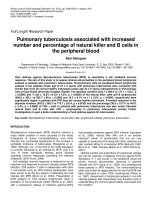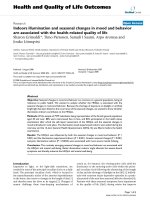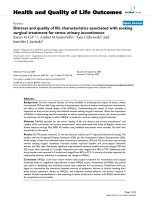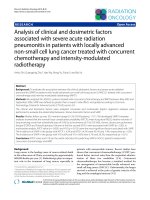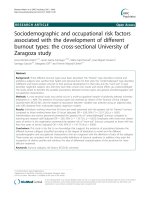Factors associated with recurrent hospitalizations and quality of life in acute exacerbation of COPD
Bạn đang xem bản rút gọn của tài liệu. Xem và tải ngay bản đầy đủ của tài liệu tại đây (597.78 KB, 77 trang )
FACTORS ASSOCIATED WITH RECURRENT
HOSPITALIZATIONS AND QUALITY OF LIFE IN ACUTE
EXACERBATION OF COPD
CAO ZHENYING
(M. Sc. (Clinical Science), NUS)
A THESIS SUBMITTED FOR THE DEGREE OF MASTER OF
MEDICINE
DEPARTMENT OF COMMUNITY OCCUPATIONAL AND FAMILY
MEDICINE
NATIONAL UNIVERSITY OF SINGAPORE
2003
i
ACKNOWLEDGEMENTS
Supervisers:
A/Prof Ng Tze Pin
Department of Community, Occupational and Family Medicine, Faculty of Medicine,
National University of Singapore
Prof Tan Wan Cheng
Respiratory Medicine Division, Department of Medicine, Faculty of Medicine, National
University of Singapore
Collaborators:
A/Prof Philip Eng
Department of Respiratory &Critical Care Medicine, Singapore General Hospital
Dr. Ong Kian Chung
Department of Respiratory Medicine, Tan Tock Seng Hospital, Singapore
ii
TABLE OF CONTENTS
Acknowledgements…………………………………………………………………….....i
Table of Contents…………………………………………………………………………ii
Summary……………………………………………………………………………….....v
List of Tables………………………………………………………………………..…....viii
Abbreviations………………………………………………………………………….....ix
Publications Arising from Work in this Thesis………………………………………....x
1
Introduction…………………………………………………………………………..1
1.1 Literature Review………………..……………………………………..……….1
1.1.1 Definition of COPD and AECOPD………………………………………….1
1.1.2 Outcomes of COPD………………………………………………………….2
1.1.2.1 Mortality …………………………………………………………….2
1.1.2.2 Hospitalization and Rehospitalization …………………...….……….3
1.1.2.3 Quality of Life …………………………………………………….....4
1.1.3 Risk Factors of AECOPD…………………………….……………………...6
1.1.3.1. Infection …………………………………………………………….6
1.1.3.2. Forced Expiratory Volume in 1 s (FEV1) …………………………...8
iii
1.1.3.3. Low Body Mass Index (BMI)……………………………………….9
1.1.3.4. Chronic Mucus Hypersecretion (CMH) …………………………...10
1.1.3.5. Co-morbidity ……………………………………………………….11
1.1.3.6. Psychological Distress ……………………………………………..11
1.1.3.7. Management Factors and Home Care .....……………………..........12
1.2 Objectives………………..…………………………………………….………..15
2
Methods……………………………………………………………………………...16
2.1 Study Design………………………………………………………….………....16
2.2 Study Population and Selection Criteria……………………….………….….16
2.3 Outcomes and Associated Factors………………………………..….………..18
2.4 Measures at Initial Interview…………………………………….……………18
2.5 Measures at Re-interview………………………………………..………...…..21
2.6 Method of Data Collection…………………………………..…………………23
2.7 Statistical Analysis……………………………………………..………....…….23
3
Results……………………………………………………………….………………25
3.1 Frequent Readmissions for AECOPD………………………………………...25
3.2 Quality of Life (SGQOL)………………………………………………………32
4
Discussion……………………………………………………………………………39
References……………………………………………………………………………….52
iv
Appendices……………………………………………………………………………..60
1
Appendix A: Schedule of Visits and Measurements for Patients……………… 60
2
Appendix B: Questionnaires……………………………………………………. 61
2.1 Questionnaire 1. St. George’s Respiratory Questionnaire (SGRQ).………61
2.2 Questionnaire 2. Hospital Anxiety and Depression Scale (HAD) ………....64
2.3 Questionnaire 3. Chronic Mucus Hypersecretion (CMH)………………....65
2.4 Questionnaire 4. Patient Compliance of Treatment………………………..65
2.5 Questionnaire 5. Degree of Dyspnea………………………………………...66
2.6 Questionnaire 6. Family Support --- Care-giver Efficacy………………….66
v
SUMMARY
Chronic obstructive pulmonary disease (COPD) is a common disease, associated with
high morbidity and mortality, and is a leading cause of hospitalization and death in the
elderly. Acute exacerbations contribute considerably to the diminished quality of life
(QOL) in patients with COPD. Several etiologic factors alone or in combination cause
acute exacerbation of COPD (AECOPD). Despite the rising mortality rate for COPD,
public awareness of COPD is much lower than for other lung diseases.
In Singapore, no documented data about rates of hospital readmissions for
AECOPD is available and no previous studies have investigated the factors that influence
the outcomes of care of COPD patients. The purpose of this study was to describe the
outcomes of patients with COPD in terms of the rates of repeat hospitalization for
AECOPD, and the QOL, and to evaluate factors associated with recurrent hospital
readmissions for AECOPD and the QOL of COPD patients. These factors include sociodemographic factors, clinical variables, psychologically-related factors and patient care
factors.
We conducted a cross-sectional study on 186 COPD patients who were
hospitalized for AECOPD from April 2002 to March 2003 in the respiratory medicine
departments of two large public sector general hospitals. Data on the outcome measures
and associated factors of the patients in stable state were collected immediately prior to
hospital discharge, and at one month after hospital discharge. At initial interview, we
collected 186 COPD patients’ data on socio-demographic, clinical and patient care
vi
characteristics on the day of their hospital discharge. And at re-interview, we completed
questionnaires on the quality of life (SGQOL), level of family support and psychological
distress for 146 patients at one month after their discharge.
We found during the one year period prior to the current admission of the 186
COPD patients, 85 patients (45.7%) reported two or more previous hospital readmissions.
We also found a high prevalence of current or ex-heavy smokers, malnutrition, depression
and consumption of psychotropic drugs and lack of care giver, pulmonary rehabilitation
and vaccination. The multiple logistic regression analysis showed that the duration of
COPD >5 years, lower FEV1% (<50%), consumption of psychotropic drugs and receipt of
vaccination were significantly independently associated with frequent hospital
readmissions. Frequent hospital readmissions (>=2) and depression were significantly
independently associated with worse Symptom Scores of the SGQOL. Older age (>=75
years), frequent hospital readmissions, lower FEV1%, severe dyspnea (degree of dyspnea
>=3) and depression were significantly associated with worse Activity Scores. Lower
FEV1%, severe dyspnea, anxiety, depression and poor housing type were independently
associated with worse Impact Scores. Frequent hospital readmissions, lower FEV1%,
severe dyspnea, anxiety and depression were significantly independently associated with
worse Total Scores.
In conclusion, this study has identified several factors that are associated with
frequent readmissions and poor QOL and indicates that this disease remains poorly
understood and an inadequately managed health problem, and that the QOL is worse in
those with frequent admissions. These results of our study confirm that readmission for
vii
AECOPD and poor QOL were associated with disease severity, psychosocial and health
care factors.
viii
LIST OF TABLES
Table 1.
Socio-demographic characteristics of COPD patients with frequent and
non-frequent re-admissions
Table 2.
Clinical characteristics of COPD patients with frequent and nonfrequent re-admissions
Table 3.
Patient care characteristics of COPD patients with frequent and nonfrequent re-admissions
Table 4.
Factors significantly associated with frequent re-admissions in COPD
(Results of forward stepwise selection multiple logistic regression)
Table 5.
SGQOL Scores, Mean (SD) by socio-demographic characteristics of
COPD patients
Table 6.
SGQOL Scores, Mean (SD) by clinically-related characteristics of
COPD patients
Table 7.
SGQOL Scores, Mean (SD) by psychologically-related characteristics
of COPD patients
Table 8.
SGQOL Scores, Mean (SD), by patient care characteristics of COPD
patients
Table 9.
Factors significantly associated with SGQOL scores from forward
selection multiple regression analyses.
.
ix
ABBREVIATIONS
AECB
acute exacerbation of chronic bronchitis
AECOPD
acute exacerbation of chronic obstructive pulmonary disease
BMI
body mass index
BPQ
Breathing Problems Questionnaire
CMH
chronic mucus hypersecretion
COPD
chronic obstructive pulmonary disease
CRQ
Chronic Respiratory Questionnaire
FEV1
forced expiratory volume in 1 s
FEV1%
forced expiratory volume in 1 s percentage predicted
HAD
Hospital Anxiety and Depression Scale
HRQL
health-related quality of life
ICU
intensive care unit
LTOT
long-term oxygen therapy
QOL
quality of life
SF-36
36-item short-form
SGRQ
St. George’s Hospital Respiratory Questionnaire
SGQOL
St. George’s quality of life
SIP
sickness Impact Profile
x
PUBLICATIONS ARISING FROM WORK IN THIS THESIS
Title: Factors Associated with Recurrent Hospitalizations and Quality of Life in Acute
Exacerbation of COPD
Abstract submitted and posted in 7TH NUS-NUH Annual Scientific Meeting. 2 & 3
October, 2003. Singapore
1
INTRODUCTION
LITERATURE REVIEW
Chronic obstructive pulmonary disease (COPD) is a common disease which is associated
with high morbidity and mortality. It is a leading cause of hospitalization and death in the
elderly. COPD serves as the fourth leading cause of death in North America, behind heart
disease, cancer, and stroke, and is the only leading cause of death that is rising in
prevalence [1] [2]. Despite the rising mortality rate for COPD, public awareness of COPD is
much lower than for other lung diseases.
DEFINITION OF COPD AND AECOPD
According to the definition of the Global Initiative for Chronic Obstructive Lung Diseases
[3]
, COPD is a disease state characterized by airflow limitation that is not fully reversible.
The airflow limitation is usually both progressive and associated with an abnormal
inflammatory response of the lungs to noxious particles or gases. The definition of acute
exacerbation of COPD (AECOPD) reached by a working group of respiratory physicians
from the United States and Europe was as follows: ‘a sustained worsening of the patient's
condition, from the stable state and beyond normal day-to-day variations, that is acute in
onset and necessitates a change in regular medication in a patient with underlying COPD’
[4]
.
2
OUTCOMES OF COPD
Mortality
COPD is associated with substantial morbidity and mortality worldwide, and is expected
to become the third leading cause of death and the fifth leading cause of disability by the
year 2020 [5]. The WHO estimated 2.74 million deaths worldwide from COPD in 2000. In
United States, mortality from COPD increased by 40% between 1979 and 1998. But
prevalence, morbidity and mortality of COPD vary appreciably across countries and
across different groups within countries. Even in developed countries, accurate
epidemiological data on COPD are difficult and expensive to collect. Data from the third
National Health and Nutrition Examination Survey (NHANES III) showed that 24 million
adults in the United States had mild or moderate obstructive lung disease, compared with
10 million adults reported a diagnosis of COPD responding to the National Health
Interview Survey. It suggests that COPD is significantly under-diagnosed
[6]
. The
imprecise and variable definitions of COPD have made it hard to quantify the morbidity
and mortality of this disease in developed
[7]
and developing countries. There is also a
scarcity of data on COPD morbidity and mortality in Asian populations.
Hospitalization for patients with acute exacerbations carries an associated inhospital mortality of 6 to 26% [8] [9] [10], and the long-term outcome is poor. In persons with
FEV1 values < 0.75 L, the approximate mortality rate at 1 yr is 30% and at 10 yr 95% [11].
For those patients requiring prolonged mechanical ventilation in an intensive care unit
(ICU) for an acute exacerbation, in-hospital mortality rates are substantially higher: 35%
to 50% [12] [13] [14] [15], 1-year post-hospitalization mortality rates reach 40 to 65% [16] [17] [18]
[19] [20]
which is even higher for patients older than 65 years [19].
3
Hospitalization and Rehospitalization
Hospitalization rates for COPD in many developed countries are rising dramatically.
Investigators at the National Center for Health Statistics evaluated the trends in COPDrelated hospital discharges using data from the National Hospital Discharge Survey. In the
United States, an estimated 553,000 hospital discharges were reported in 1995, a rate of
21.2 per 10,000 population. Between 1992 and 1995, the overall discharge rate increased
by 25.4%
[21]
. In Singapore, hospitalization rates from 1991 to 1998 have increased
significantly among Malays and Indians [22]. COPD places a high economic burden on the
healthcare system and society in all countries studied, with a particularly pronounced
impact in the U.S.A and Spain
[23]
. In the United States, the burden of COPD is
particularly high in secondary care, with over 660,000 hospital discharges for COPD
recorded in 1998
[24]
. The annual cost of hospital care for COPD in the U.S.A. was
estimated at US$7.3 billion in 2000, 40% of the total direct (medical care) cost of the
disease (US$18.0 billion) [25].
Most hospitalizations for COPD are due to acute exacerbations. Hospitalization for
acute exacerbation of COPD usually occurs in the advanced phase of disease. Half of
those patients who are hospitalized are expected to be readmitted at least once in the
ensuing 6 months
[26] [27]
. Sara L. Douglas et al
[20]
performed a prospective longitudinal
study on 538 ICU patients who required >24 hrs of continuous in-hospital mechanical
ventilation. It was indicated that over half of all patients alive at their index hospital
discharge had at least one rehospitalization within the following 12 months. A majority
(86%) of rehospitalizations occurred within the first 3 months after the index hospital
4
discharge. The 1-yr cumulative rehospitalization rate for long-term ventilator patients was
52.6%, compared with 53.3% for short-term ventilator patients [20].
Quality of Life
After an acute exacerbation, most patients are expected to experience at least a temporary
decrement in quality of life [28] [29] [30].
A variety of studies exist as to methods of assessing quality of life in COPD.
Cullen DL
[31]
identified 37 measures of COPD quality of life and functional status
reported in selected literature in 1994-1997. Of these eight were measures of general
health, 10 were COPD/disease-specific questionnaires, and 19 were functional status
indices. Generic instruments provide a summary of health-related quality of life (HRQL),
and specific instruments focus on problems associated with single disease states, patient
groups, or areas of function. [32]
Singh SJ
[33]
compared three disease-specific health-status measures to evaluate
the outcome of pulmonary rehabilitation in COPD. The three disease-specific
questionnaires are the Chronic Respiratory Questionnaire (CRQ), the St. George's
Hospital Respiratory Questionnaire (SGRQ) and the Breathing Problems Questionnaire
(BPQ). All three disease-specific measures were responsive to pulmonary rehabilitation.
However the operator-led CRQ appears to be the most sensitive short-term outcome
measure. In Hajiro T's
[34]
study the frequency distributions of the questionnaire scores
showed that the SGRQ and the CRQ were normally distributed and that the BPQ was
5
skewed toward low scores. And the BPQ was found to be less discriminatory than the
SGRQ and the CRQ in evaluating HRQL cross-sectionally. The SGRQ and CRQ have
been showed precise, valid, and responsive and used extensively in the study of patients
with COPD.
Many generic measurements of HRQL, such as the 36-item short-form (SF-36),
the 20-item Medical Outcomes Study short-form, sickness Impact Profile (SIP), have been
used to measure HRQL. But their application to therapeutic trials in COPD may be
limited by low sensitivity. The SIP appears to be relatively insensitive for mild to
moderate airways disease and may not detect changes in health. In contrast, diseasespecific questionnaires may be more sensitive because a much higher proportion of their
content is directly relevant to the disease under study. [35] Sometimes the SGRQ and SF-36
were simultaneously used in COPD study [36].
In many studies quality of life was measured by the SGRQ. A study was carried
out in all acute medical wards of Aberdeen Royal Infirmary, Woodend and City Hospitals,
Aberdeen over 12 months.
[14]
A total of 377 patients admitted with an exacerbation of
COPD were identified in this time and 266 patients completed the SGRQ. Higher (worse)
scores on the SGRQ were significantly related to readmission for COPD in the next 12
months and Impact Scores were related to nebuliser provision independent of
physiological measures of disease severity. Seemungal TA et al
[15]
found the SGRQ total
and component scores were significantly worse in the frequent exacerbation group (E = 3
to 8 in a year follow-up) and suggested that patient quality of life was related to COPD
exacerbation frequency.
6
The SGRQ, CRQ and BPQ questionnaires had weak correlations with some
physiologic variables (VC, FEV1, and DL(CO)/VA) in Hajiro T’s study
[34]
. And
pulmonary function and HRQL appear to highlight different aspects of disease severity in
COPD. Therefore, both measures should be taken into account in order to get a complete
picture of severity of disease.
RISK FACTORS OF AECOPD
Acute exacerbations contribute considerably to the morbidity and the diminished quality
of life in patients with COPD. Several etiologic factors alone or in combination cause
AECOPD. The major etiologic factor of AECOPD is infection of the respiratory tract [37],
[38] [39]
. These include vaccine-preventable infections like
principally viral infections
influenza and pneumococcus. Other factors including chronic mucus hypersecretion,
malnutrition, home care, socio-economic factor and co-morbidity may also play a role in
COPD exacerbation [40] [41] [42] [43].
Infection
Numerous studies have been conducted to investigate airway infections as etiologic
factors involved in COPD exacerbations. In a longitudinal study of a cohort of patients
with moderate to severe COPD, lower respiratory tract infection was the most common
identified cause of death
[37]
Nigeria from 1990 to 1999
. Erhabor and Kolawole reviewed mortality due to COPD in
[44]
. Out of 161 admissions, there were 41 deaths, accounting
7
for a mortality rate of 25.5%. Respiratory tract infection, lower socio-economic group and
extremes of age were the most commonly identified risk factors for death. In a recent
study, it is found that the frequency of infective exacerbations was a major determinant of
the quality of life of patients with bronchiectasis
[45]
. But no study has investigated
associations between bacterial or viral infections and health-related quality of life in
COPD patients. Furthermore, there are very few published studies that have investigated
associations between infections and rehospitalizations. In a heavily influenza-vaccinated
cohort study of older COPD adults (approximately 90% vaccinated each year), half of
COPD subjects with moderate/severe COPD had at least one emergency-center visit
and/or hospitalization for acute exacerbation and respiratory tract viral infections were
documented in 23% of hospitalizations
[46]
. Although randomized trials of influenza
vaccination in specific COPD populations have not been reported, the administration of
the vaccine in elderly patients with COPD has been associated with a reduction in the risk
of hospital admissions, outpatient visits, and mortality [47].
The relationship between bacterial infection and COPD exacerbations is not
precisely understood. Bacterial pathogens are present in around half of acute exacerbation
patients [48] [49]. But it is difficult to determine the frequency in which bacterial infection is
the major or sole cause of an exacerbation of COPD. Often, more than one possible
explanation for an exacerbation is present, such as a viral upper respiratory tract infection
or a co-morbid illness
[50]
. The difficulty of differentiating an active infection versus
chronic colonization of the lower airways adds to this dilemma. Bronchoscopic studies,
using sterile protected specimen brush, also have shown that approximately 25% of stable
patients with COPD are colonized with potentially pathogenic bacteria [48] [51] [52]. Some
8
authors suggest that there is no compelling evidence that bacteria play a role in acute
exacerbations
[53]
. Although bacterial colonization of the distal airways is common in
stable COPD, patients with exacerbations often have higher numbers of organisms
[54].
Streptococcus pneumoniae, Haemophilus influenzae and pneumococci [55] [56] represent the
majority of isolated bacteria. Thus, the background of colonization in the stable state has
led to uncertainty concerning the role of bacteria during exacerbations.
Studies have shown that respiratory viruses produce longer and more severe
exacerbations and have a major impact on health-care utilization.
[57] [58]
. Two recent
studies [57] [46] reported that at least one third of COPD exacerbations were associated with
viral infections. Three rigorous studies
[59] [60] [61]
showed 18% to 34% of exacerbations
attributed to viral (or mycoplasma) illness, and Influenza, parainfluenza, and coronavirus
were the most frequent pathogens to be significantly associated with exacerbations.
Estimates of the proportion of COPD exacerbations associated with viral infection range
greatly from 7%
[62]
to 63%
[63]
due to significant differences in study design. Several
studies lacked adequate control by failing to record the frequency of viral infection during
exacerbation-free periods. Others attempted to detect only selected pathogens. Variability
in the definition of an exacerbation is another factor that may affect the percentage of
exacerbations caused by viral illness. Finally, different serologic and isolation techniques
account for some of the variety in study results. [54]
Forced Expiratory Volume in 1 s (FEV1)
The most commonly used way to express disease severity in COPD is by assessing the
forced expiratory volume in 1 s (FEV1) as a measure of airway obstruction
[64]
. Both the
9
American Thoracic Society and the European Respiratory Society recommended a staging
system for the assessment of COPD severity on the basis of actual FEV1 as a percentage
of predicted (FEV1%pred) [65] [66].
FEV1 is, besides age, considered to be the most important predictor of mortality in
patients with COPD [67] [68]. However, a cross-sectional observational study on ambulatory
COPD patients performed by Miravitlles M et al in 201 general practices located
throughout Spain showed that FEV1 impairment explained only part of the risk of frequent
exacerbations and hospital admissions
[69]
. Furthermore, it is difficult to compare or
summarize results of different studies because there is considerable heterogeneity in
outcome measures, instruments used, and study populations included.
Low Body Mass Index (BMI)
Weight loss is a frequently occurring complication in patients with COPD. Pouw EM et al
[70]
performed a retrospective case-control study on AECOPD hospital admissions in 1994
and 1995 in a hospital in Netherlands. Cases were nonselectively readmitted within 14
days after prior discharge and controls were not readmitted within 3 months. This study
indicated weight loss during hospitalization and low BMI on admission were related to the
increased risk of unplanned hospital readmission. Low BMI is an independent risk factor
for mortality of COPD, and its association is strongest in subjects with severe COPD [40].
Landbo C et al [40] performed a prospective study in total 1,218 men and 914 women with
COPD from the Copenhagen City Heart Study. They analyzed mortality from COPD and
from all causes during 17 yr of follow-up. After adjustment for age, ventilatory function,
and smoking habits, low BMI was predictive of a poor prognosis (i.e., higher mortality),
10
with relative risks (RRs) in underweight subjects as compared with that in subjects of
normal weight of 1.64 in men and 1.42 in women. And the strongest association was
found in severe COPD with RR for low versus high BMI 7.11. In a retrospective study
with 400 COPD patients none of whom had received nutritional therapy, Schols AM et al
[42]
revealed that low BMI (p < 0.001), age (p < 0.0001) and low PaO2 (p < 0.05) were
significant independent predictor of increased mortality. Moreover, a recent crosssectional study on 300 COPD outpatients in Europe showed that malnutrition was highly
prevalent in home-assisted respiratory patients and was related to forced expiratory
volume in one second
[71]
. In order to identify factors associated with the health-related
quality of life (HRQL) perceived by patients with stable COPD, de La Fuente Cid R
performed a prospective cohort study on 204 stable COPD patients in Spain and indicated
that HRQL in stable COPD patients was partially related to nutritional status [72].
Chronic Mucus Hypersecretion (CMH)
A cross-sectional observational study on ambulatory COPD patients performed by
Miravitlles M et al [69] in 201 general practices located throughout Spain showed chronic
mucus hypersecretion (CMH) was significantly associated with the risk of frequent
exacerbations while FEV1 impairment explained only part of the risk of frequent
exacerbations and hospital admissions. COPD patients with CMH were more likely to die
from pulmonary infection than COPD patients without CMH in a study on 14,223
subjects followed for 10-12 years.
[43]
In contrast to these studies, a prospective cohort
study over 15 years on subjects who had participated in the Copenhagen City Heart Study
and were hospitalized with a discharge diagnosis of COPD found that the presence of
CMH was not strongly associated with prognosis. However, mortality risk increased with
11
decreasing FEV1% predicted. [73]
Co-morbidity
A cross-sectional study by Miravitlles M et al also indicated that severity of exacerbations
provoking hospital admissions was associated with the presence of significant comorbidity. A prospectively study
[42]
on 2,414 ambulatory patients with AECB from 268
general practices located throughout Spain suggested that baseline characteristics of the
patients such as degree of dyspnea, coexisting ischaemic heart disease and number of
previous visits to the general practitioner for respiratory problems are strongly associated
with increased risk of relapse after ambulatory treatment of acute exacerbations of chronic
bronchitis. In contrast, another prospective study on patients with moderate to severe
COPD indicated that co-morbidities with COPD had not a significant impact on the risk
of hospitalization for acute exacerbation
[69]
. Multivariate analysis showed that only
PaCO2 and Ppa were independently related to the risk of hospitalization for acute
exacerbation of COPD.
Psychological Distress
Many patients experience anxiety, depression, fatigue, coping difficulties, and somatic
preoccupation
[74]
, symptoms that may be related to the dyspnea associated with COPD.
Inability to work and decreased capacity to participate in social and recreational activities
are common and often lead to depression [75].
Raffaele Antonelli Incalzi
[103]
analyzed the effects of COPD on health status,
assessed by the Saint George's Respiratory Questionnaire (SGRQ) and five generic
12
outcomes: Barthel's index, 6-min walk test, mini mental state examination, geriatric
depression scale, and quality-of-sleep index, in elderly patients in the Salute Respiratoria
nell'Anziano Study from 1996 to 1997. The relatively low prevalence and the strong
associated power of depression in this study testified that depression was an important
marker of worse QOL in COPD patients. Although we know that the prevalence of
depression in patients with advanced COPD is high
[77]
, few studies have explored the
relationship in COPD between depression and mortality. In a prospective study of 16
patients with advanced COPD, Ashutosh et al
[78]
reported greater mortality at 4 years in
depressed patients, even when differences in FEV1 were not present. Pedro Almagro’s
prospective cohort study
[79]
of a larger series confirms that finding, he observed a strong
relationship on 135 patients hospitalized for AECOPD between the presence of depression,
assessed on the Yesavage scale, and medium-term mortality (death between 1 year and 3
years after discharge).
Management Factors and Home Care
Comprehensive medical management starts with prevention which includes smoking
cessation and immunization against influenza virus and pneumonia bacteria, but over time
adds bronchodilators, anti-inflammatories, oxygen, adequate nutrition, exercise, control of
anxiety and depression, and exacerbation management [80] [81] Kessler R et al [82] assessed
the frequencies of potentially modifiable risk factors of COPD exacerbation in patients
hospitalized for this reason and found a moderate to high prevalence, suggesting
unsatisfactory features in their management. This study recruited 353 patients with
median forced expiratory volume in one second (FEV1) 31% of predicted and mean
partial pressure of oxygen (PO2) 63+/-13 mmHg. Of these patients, 28% had not received
13
an influenza vaccination; a high number (86%) did not attend rehabilitation programmes;
28% of patients with PO2 < or =55 mmHg were not using long-term oxygen therapy
(LTOT); among LTOT users, 18% used it <15 h a day; 43% of the total failed in some of
the essential inhaler manoeuvres; 26% were current smokers; 21% of noncurrent smokers
were exposed to passive smoking at home.
Several studies
[83] [84]
have found that patient compliance with COPD therapy is
extremely poor. In the Lung Health Study, patient compliance with inhaled bronchodilator
therapy by self-report at follow-up year 1 was just over 60%, declining to < 50% at year 5
[84]
. Generally, three types of noncompliance have been observed in COPD patients on
chronic therapy: undercompliance, overcompliance, and improper use. Undercompliance
is probably the most common compliance problem in COPD therapy, although improper
use is also common. It is important to note that more than one type of noncompliance is
possible in the same individual. Thus, studies that estimate noncompliance on the basis of
one type of observed behavior probably underestimate the level of the problem [85]. At the
same time, the family also plays an essential role in the life of the COPD patient with
advancing disease. Family interaction requires that they have an understanding of the
disease process and what to expect. But not all families are supportive; some family
members may become disinterested or even hostile.
Home care provided by respiratory therapists, such as oxygen, breathing
equipment, supplies, and educating patients in use, cleaning, and maintenance of
equipment, can significantly reduce the rehospitalization of COPD patients. A study on
the effect of home respiratory therapy on hospital readmission rates in 418 patients with
14
COPD was performed by Roselle S and D'Amico FJ
[28]
. In the year prior to home
respiratory therapy, the average number of hospital admissions per patient had been 1.28,
with the average length of hospital stay being 18.25 days. During the home respiratory
therapy study period of 12 months, the average number of hospital admissions was 0.48,
with the average length of hospital stay being 6.09 days.
The quality of post-hospitalization discharge care, in particular, pulmonary
rehabilitation programmes of patient education and physiotherapy [70], is also an important
determinant of outcomes. The goals of pulmonary rehabilitation are to enhance standard
medical therapy and maximize functional capacity. Several studies have analyzed COPD
patients' hospital and medical resource utilization before and after rehabilitation [86] [87]. In
a randomized controlled study, Jensen
[88]
found that pulmonary rehabilitation led to
significantly fewer hospitalizations over a 6 months follow-up of patients with COPD.
Lertzman and Cherniack
[87]
reported an average decrease of 20 hospital days in the year
after pulmonary rehabilitation, resulting in an estimated savings of $2,000 per patient.
However, there have been no prospective randomized controlled studies that provide
conclusive evidence regarding survival of COPD patients after pulmonary rehabilitation.
Morbidity and mortality rates for COPD are inversely related to socioeconomic
status and are higher in blue-collar than white-collar workers
Cid’s prospective cohort study
[72]
[92] [93]
. In de La Fuente
, health-related quality of life in 204 stable COPD
patients is also partially related to socioeconomic status.

